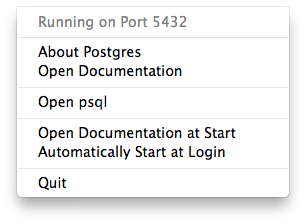

POSTGRES APP M1 CODE
make -j 3 || echo "Build failed with exit code $?" Prerequisites for building the binariesĪt the very least, you need the following: However, parallel builds make debugging problems a lot harder, so don't use them when something doesn't work.Īlways check the exit code of make to see if any errors occurred, eg.

Since my macOS 10.12 VM is limited to 2 virtual CPUs, I use -j 3. My recommendation is to use one more job than the number of logical processors you have. make -j 3 postgresql) for parallel builds. If you want to change the version number of any of the dependencies, edit the makefile (all version numbers are specified at the top). So for best results, make sure that directory is empty before starting the build.
POSTGRES APP M1 INSTALL
The makefile will install all products in /Applications/Postgres.app/Contents/Versions/xx (xx is the major version of PostgreSQL). PostGIS and especially plv8 take a long time to build, so if you don't need them, type make postgresql instead. The default target ( all) builds postgresql, postgis, plv8, and wal2json.
POSTGRES APP M1 DOWNLOAD
The makefile will download and build many gigabytes of sources. If you have all the prerequisites installed (see below), you can just type make. The directories src-10, src-11 and src-12 each contain a makefile that downloads and builds all the binaries. If you want to build your own versions of all the PostgreSQL binaries, you have slightly more work to do. Any help migrating to Swift 5 would be greatly appreciated! Building the Binaries Open the XCode file and start hacking!Ĭurrently it is not possible to use Xcode 11 because Postgres.app is written in Swift 3. So just make sure you have a copy of Postgres.app in your applications folder. By default, the buildscript for Postgres.app just copies the binaries from /Applications/Postgres.app/Contents/Versions If you want to work on the user interface only, you don't have to re-compile the binaries yourself. It is of course possible to use other versions of macOS / Xcode (see details below), but those are the environments we use. The GUI is built on macOS 10.15 with Xcode 10.1 The binaries for PostgreSQL 11 - 12 are built on macOS 10.12 with Xcode 8.3.3 The binaries for PostgreSQL 9.4 - 10 are built on macOS 10.10 with Xcode 7.2.1 This is the native Mac app that you see when you double click Postgres.app in the Finder.įor compatibility reasons we build the different parts on different versions of macOS. The Postgres.app user interface, written in Swift. You can find the binaries in /Applications/Postgres.app/Contents/Versions The PostgreSQL binaries, including extensions and a bunch of command line tools. Documentationĭocumentation is available at, as well as from the "Open Documentation" menu item in Postgres.app. Older versions and pre-releases are available in the releases section on GitHub. You can download recent versions of Postgres.app from the Postgres.app website. Run Multiple Versions of PostgreSQL simultaneously.Comes with a pretty GUI to start / stop servers.Includes everything you need to get started with PostgreSQL.The easiest way to run PostgreSQL on your Mac


 0 kommentar(er)
0 kommentar(er)
